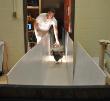
No Fowl Play: Researchers Find Slip-and-Fall Secrets
Moving quickly in a forward, firm-footed stance across a slippery surface is less likely to result in a fall than moving slowly, they discovered.
Two biomechanics researchers, Timothy Higham of Clemson University and Andrew Clark of the College of Charleston, have published results of a study that could help people avoid slipping and falling on a slippery surface. The two studied helmeted guinea fowl walking along a 6-foot rough and slippery surfaces and discovered that moving quickly in a forward, firm-footed stance across a slippery surface is less likely to result in a fall than moving slowly, because moving slowly as one reaches the slippery area hinders the necessary task of shifting the center of mass forward.
Their study "Slipping, sliding and stability: locomotor strategies for overcoming low-friction surfaces," is published in the Journal of Experimental Biology (Vol. 214, pp. 1369-1378).
Helmeted guinea fowl react to slips very much as human beings do, and the joints in the fowls' legs function similarly to human knees and ankles: The position of the knee relative to the foot can create joint angles that can cause or prevent loss of balance on slippery surfaces, they say. Once the knee passes the ankle during contact with slippery ground, slipping stops.
"The findings can be useful in helping humans, especially older ones, make their way across surfaces that are wet, icy or oily," said Higham. "The key to avoiding slips seems to be speed and keeping the body mass forward, slightly ahead of the ankles after the foot contacts the ground." Clark and Higham say the slip distance also is important. For a guinea fowl to fall, it needed to slip a minimum of 10 centimeters -- just under 4 inches. The distance is the same for humans, Higham said.